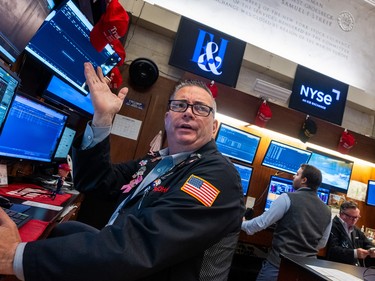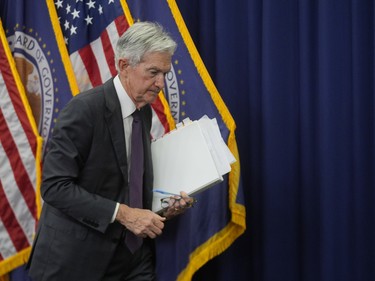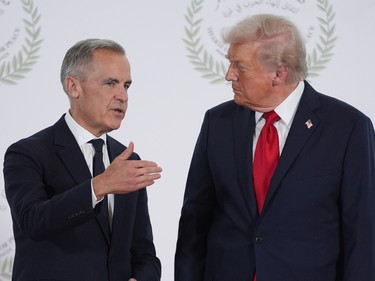With US$37 trillion in debt and a rising deficit, the next great financial calamity could be. But the U.S. is not alone

Article content
Yields on United States Treasury bonds were expected to fall when President Donald Trump unleashed a torrent of double-digit tariffs on more than 80 countries on his so-called Liberation Day in April. And at first, they did, as investors, weighing the fallout from the unprecedented shift in trade policy, abandoned stocks and rushed to safe haven assets. But then something changed.
Advertisement 2
Article content
While stocks slid, bond prices also began to fall, pushing yields upward on both 10-year and 30-year securities, a sign that investors saw more risk over the longer term in the country whose bonds and currency underpin much of the global financial system.
Article content
Article content
Article content
As the yield on 10-year Treasuries jumped to 4.5 per cent from 3.9 per cent and 30-year yields pushed through the psychological barrier of five per cent, the safest market in the world suddenly started to look familiar to Mark Manger, director of the global economic policy lab at the University of Toronto’s Munk School, whose focus on sovereign debt has drawn him to study countries at risk of default, such as Argentina and Nigeria.
Seeing the unusual — yet recognizable — hallmarks of spiking yields in the U.S. Treasuries market, even temporarily, was disconcerting.
“It’s the part where observers are starting to freak out,” he said, “because that’s not how it’s supposed to be.”
The tremors caused even a determined Trump to tap the brakes on his tariff onslaught, but not before raising serious questions about the how long the U.S. government can continue to service its swelling US$37-trillion wall of debt and whether it could precipitate, or significantly exacerbate, the next global financial crisis.
Article content
Like many countries around the world, the United States has seen its debt skyrocket since the pandemic. It is now running a deficit of nearly US$1.8 trillion, or six per cent of GDP, that is still tracking higher despite a prominent but mostly failed attempt, lead by Tesla Inc. chief executive Elon Musk, to reign in spending.
Article content

With political polarization at an all time high and no easy solution in sight, the April episode offered one of the first real-time glimpses of a scenario few in financial markets have been willing to contemplate: that U.S. debt will play a central role in the next great financial calamity.
Sovereign debt has spooked investors from the U.K. to Japan in recent years, with bond investors suddenly questioning the fiscal plans of governments that have been able to bleed red ink with relative impunity for decades. But the ramifications of a crisis emanating from the engine of the global economy, either directly or through contagion, would be far reaching and devastating, economists say.
“All finance theory is built around this idea that the U.S. government debt is the ultimate safe asset. Everything is priced relative to it,” Manger said.
A sustained breakdown in the U.S. Treasury market could cause a global financial crisis that erodes asset values, destabilizes financial institutions and pushes economies into recession, according to a February analysis by the non-partisan Brookings Institution. Moreover, the assessment suggested, it wouldn’t necessarily take a true default to trigger a crisis, just fears that the deteriorating fiscal situation would make a strategic default plausible.
Article content
Juan Carlos Hatchondo, an economics professor at Western University who specializes in sovereign debt issues, said the ubiquity of U.S. Treasuries and other government-backed securities, which dominate global debt markets and can be found on the balance sheets of financial players from pension funds to banking giants, would raise the stakes dramatically.
“A significant decrease in their value (would) trigger a broad financial crisis,” Hatchondo said.
Even the overnight transactions that allow banks to balance their daily accounts — known as repurchase or “repo” market operations — use Treasuries as collateral. A fall in their value would disrupt the circulation of liquidity through the financial system.
Then there’s the impact on other governments that hold a “significant” portion of their foreign reserves in U.S. Treasuries.
“A reduction in their value will weaken the position of governments across the world,” he said
“It just takes one trigger for somebody to call ‘time out’ on one of them to cause ripple effects”
Derek Holt, head of capital markets economics at Bank of Nova Scotia
The risk of contagion — in which a crisis spreads from country to country, gathering momentum — has only been rising.
“The bond markets around the world are very tightly integrated now, more so than in past decades,” said Derek Holt, head of capital markets economics at Bank of Nova Scotia. “One country’s bond yields getting shocked can change the appetite for many other different countries.”
Article content
Contagion becomes more of a concern as countries around the world face common drivers that are leading to more borrowing, from trade reverberations to budget challenges, Holt added.
“It just takes one trigger for somebody to call ‘time out’ on one of them to cause ripple effects,” he said, noting that there are pockets of unease beyond the U.S. that could trigger bond market shocks, including budget concerns in the U.K. and political upheaval in France.
The U.K. bond market was spooked in 2022 — creating a mini-crisis for the country’s pension funds — when then prime minister Liz Truss announced plans to fund tax cuts with borrowed money. In the summer of 2024, rising yields in Japan prompted a short burst of volatility across markets as so-called “carry trades” that feed demand for U.S. Treasuries were unwound.
The spring palpitations in the U.S. bond market came as many countries around the world, including Canada, have been grappling with increasing deficits and substantial debt piles in the wake of the pandemic that leave them more vulnerable to economic shocks.
On a global scale, public debt is projected to approach 100 percent of GDP by the end of the decade, surpassing the pandemic peak, according to the International Monetary Fund. More than a third of countries — which represent 75 per cent of global GDP and including major players such as the U.S., China, France and the U.K. — are expected to see debt increase further this year amid major policy shifts, escalating trade and geopolitical tensions, volatile markets and deteriorating economic prospects.
Article content
“Many governments, including some major advanced economies, face growing fiscal strains and have achieved only limited progress in rebuilding fiscal space,” the IMF said in an Oct. 14 report. “Without immediate action, slower economic growth, higher real interest rates, coupled with elevated debt and new spending needs — for defence, economic security, climate — will further tighten the fiscal vise.”
Fitch Ratings, meanwhile, warned in an Oct. 16 report that developed market sovereigns are facing rising exposure to bond market shock, which would lead to increases in already substantial debt and deficit loads.
“We see plausible scenarios in which an upward shift in yields increases budget deficits and debt ratios as existing liabilities roll over at higher rates, even without a classic financial bubble,” the ratings agency said.
The 30-year yields have already risen in most markets, pointing to investor caution over issues including long-term inflation, heavy bond issuance and, in some cases, fiscal sustainability.
Article content

“Weaker demand from central banks enacting quantitative tightening and from long-term investors, such as pension funds and insurers, may also be a factor in some markets, for example, Japan and the U.K.,” Fitch analysts Ed Parker and Nasir Rajah said.
Article content
Their report said government debt in developed markets is projected to rise by US$6 trillion this year alone to US$71 trillion, representing 105 per cent of GDP. That’s up from just US$28 trillion, or 68 per cent of GDP, in 2007.
The perils of interconnected markets were put into sharp focus by the 2008 global financial crisis, which tested mechanisms for mitigation, and led to the creation of new ones. The U.S. Federal Reserve and U.S. Treasury were forced to step in to provide liquidity and keep financial markets moving and could intervene again in the event of a debt crisis, potentially in coordination with The IMF, the European Commission and the European Central Bank (ECB).
But Hatchondo isn’t sure that would be enough.
“The U.S. government would be too large to bail out. It is challenging to envision a scenario in which a fiscal crisis in the U.S. is not followed by a global financial crisis, thereby undermining a global coordination effort to bail out the U.S. government,” he said. “The Fed would have to conduct massive interventions to try to prop up the Treasuries market and assist financial institutions.”
Predicting the timing of such an event is impossible because there is no red-line number that triggers a debt crisis, said Hatchondo.
Article content
“What is clear is that the U.S. is becoming increasingly more exposed to one,” he said, noting that a substantial portion of U.S. debt will need to be refinanced soon. As of June, more than 31 per cent of the U.S. debt — more than US$10 trillion — was set to mature within a year.
“If one adds a budget deficit in excess of six per cent of the GDP, the Treasury must issue debt worth approximately 37 per cent of the GDP,” he said. “If the market starts demanding a higher yield to compensate for the risk of holding U.S. bonds, debt growth will accelerate and can easily trigger a crisis.”
Ray Dalio, the billionaire founder of hedge fund Bridgewater Associates, published a book in June called How Countries Go Broke: The Big Cycle, which warns that the U.S. government debt situation is nearing the point of no return. In his view, the country is headed for a classic “death spiral” because it will need to keep issuing bonds to pay its debt. The deteriorating fiscal situation will, at some point, cause investors to demand ever higher yields, layering on more debt at higher cost.
“With this government … we don’t know what we’re going to wake up to tomorrow”
Marc-André Pigeon, assistant professor at the University of Saskatchewan’s graduate school of public policy
But Manger, who has seen what a country’s debt crisis can look like with no obvious solutions, suggested that the United States and other developed countries have options if they choose them: namely austerity and central bank intervention.
Article content
“This is not going to turn into a colossal disaster because of the difference between between an emerging market and the U.S.,” he said. “Argentina borrows in U.S. dollars, and you cannot print U.S. dollars if you are Argentina. The U.S. can always do this, so it’s ultimately a lot safer, but what they really just need to do is to not lower taxes like crazy and not spend like crazy.”
He noted that the Bank of England stepped in when markets panicked over Truss’s budget and her tenure as prime minister was short-lived.
“And those taxes were changed, and the U.K.’s fiscal position improved slightly. So that’s the kind of scenario that we could see.”
While the rising debt levels and slowing growth make it inviting to suggest the U.S. debt party is in its final innings, judging the likelihood of a default based on established metrics such as the level of debt to gross domestic product can be a dangerous game, said Marc-André Pigeon, an assistant professor at the University of Saskatchewan’s graduate school of public policy, pointing to the experience of Japan.
With public debt at around twice the country’s GDP for more than a decade, Japan was downgraded by Moody’s Investors Service as far back as 2014, but the country hasn’t defaulted, making naysayers look foolish.
Article content
“If you bought into the ‘ability to pay’ story, you’ve been wrong for years on Japan,” Pigeon said. “Go ahead, bet against the yen. Bet against the Japanese debt market. See how long you last.”
More concerning to him than rising U.S. deficits and debt is the unpredictability of the current administration and Trump’s willingness to defy convention. It’s not whether there is capacity to pay, but whether they might simply choose a path that leads to a crisis.
“With this government … we don’t know what we’re going to wake up to tomorrow,” he said. “The institutional supports for the U.S. government debt are thick and rich and not going anywhere, unless there’s bad policy decisions: rule of law, arbitrarily changing norms and rules, those are the things I worry about, not the ability to pay.”
Fitch, which became the second of three large bond-rating agencies to knock U.S. sovereign debt from its triple-A rating, in 2023, said in an Oct. 1 report that its analysis now considers factors such as a “possible erosion of checks and balances” in U.S. policy making, in addition to longstanding “intractable disputes” over public finances stemming from an aging population and entitlement spending.
Article content
Among the concerns is the administration’s frequent criticism of Federal Reserve Chairman Jerome Powell, Trump’s efforts to fire Fed governor Lisa Cook, the dismissal of Bureau of Labor Statistics head Erika McEntarfer, as well as how the administration appropriates congressionally approved budgetary allocations.
However, Fitch did not downgrade U.S. sovereign debt further, concluding that “self-correcting mechanisms,” including the country’s reserve currency status, will continue to support the debt for now.
“Despite increased uncertainty around U.S. policy and the possible erosion of institutional checks and balances, we expect the U.S. dollar’s predominant reserve currency status — a material sovereign rating strength — to continue for the foreseeable future,” the ratings agency concluded.
Article content

Part of Trump’s months-long pressure campaign on the U.S. Federal Reserve to lower interest rates is being waged as debt servicing costs balloon. Net interest on the public debt tracked by the Congressional Budget Office in its monthly budget review released Oct. 8 topped $1 trillion for the first time.
What’s more, interest payments are on track to be the fastest-growing portion of the federal budget in the coming years. The CBO projects net interest payments will total $13.8 trillion over the next decade, rising from an annual cost of $1 trillion in 2026 to $1.8 trillion in 2035.
Article content
There are expected offsets, though. It’s estimated that the increased tariff haul will bring in around US$300 billion a year, up from just US$77 billion in 2024, which should narrow the deficit to 6.8 per cent of GDP from 7.7 per cent, according to the Fitch Ratings report. Some $195 billion was already collected from April through the end of the fiscal year in September.
However, once legislated tax cuts kick in, the deficit to GDP ratio will rise again to 7.4 per cent of GDP in both 2026 and 2027. The U.S. general government debt-to-GDP ratio will rise to 122 per cent by the end of 2027, Fitch said, more than double the median for its ‘AA’ rated sovereigns at the end of fiscal 2024. The IMF, meanwhile, has projected U.S. debt-to-GDP ratio will continue to rise to 143.4 per cent by the end of the decade, surpassing the ratios of long-time European laggards Greece and Italy, which will see their positions improve.
The United States is arguably the most likely source of global contagion, but Japan and France are also in the mix, said Ross Schaap, head of research at GeoQuant, a division of Fitch that produces and analyzes data to assess country risk.
Japan’s rising interest rates after years of low and even negative rates have already caused market tremors as investors moved to unwind leveraged trades aimed at taking advantage of low borrowing costs to buy higher-return bonds elsewhere. But while markets stabilized quickly in August of 2024, Trump had not yet been elected to his second term.
Article content
“Markets could still trust that backstop currency swap agreements meant there was no real chance of a contagion-level blow up, just volatile adjustments in the short-term,” Schaap said. “How might Trump use such leverage?”
“(Institutional investors) might look at Germany, and say, ‘Well, I’m not going to offer this much, I’m going to price this a little lower, because the U.S. is also now priced lower”
Ross Schaap, head of research at GeoQuant
For France, the contagion-triggering concerns lie in political gridlock and a large budget deficit, with a unique reliance on borrowed foreign-currency funds.
“Paris borrows in a currency it cannot print … unlike the U.S. or Japan, which can inflate their way out of dire straits,” he said.
“And while Germany and other EU members with stronger balance sheets look to invest in domestic and security capacities, eurozone sovereign rates are likely to remain elevated relative to what would happen if France had an independent currency.”
Manger, who has advised governments in Canada and Japan, said global investor sentiment plays a large role in whether a small crisis in one country’s bond market sparks upheaval in others, even when conditions vary from country to country.
“(Institutional investors) might look at Germany, and say, ‘Well, I’m not going to offer this much, I’m going to price this a little lower, because the U.S. is also now priced lower,’” he said.
Article content
Canada is arguably in a better fiscal state than many countries around the world, including the debt-burdened United States, but it, too, could be vulnerable to a broader market shakeup driven by a sudden distaste for sovereign bonds, particularly as a relatively small economy on the world stage.
Trump’s trade war and other protectionist polices have put Canada among the countries increasing deficits, contrary to the reversals pledged by the previous Liberal government under Justin Trudeau. Prime Minister Mark Carney will unveil the latest projections in his first budget Nov. 4.
Article content

A report from Canada’s Parliamentary Budget Office in September said the deficit is expected to grow to $68.5 billion this year but Holt, the Scotia economist, pegs the figure somewhere between $75 billion and $100 billion, with the top end more than twice the amount forecast by Ottawa just last December.
He said he can envision a scenario in which Canada’s debt-to-GDP ratio doubles or even triples in the next few years and warned that the country “should not take our Triple-A status for granted” as the government rolls out expensive infrastructure projects aimed at lessening trade dependence on the United States.
Article content
“We’ve been in an environment of these rolling sovereign debt shocks, and I think we need to be very careful about being the next one, especially as the global economic outlook is looking pretty frail in the context of the U.S.-motivated trade wars,” Holt said.
“Canada (represents) two per cent or less of everything in the world markets and global market participants aren’t going to spend the same amount of time thinking about sovereign credit risks facing a country like Canada. “When you go down a path of raising the risks around your deficits and debt, they’ll just get out.’”
• Email: bshecter@postmedia.com
Article content

